The telephonic heart: A "machine autopsy" in Ottawa
06 May 2013 – Cathy Stanton
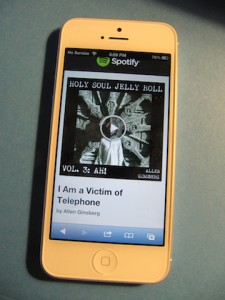 This spring, I’ve been teaching an urban anthropology class at Tufts University. In the class session before I left for the National Council on Public History conference, we talked about how digital technologies have become ever more interwoven with urban experience. The session before that was on sites of urban violence and memorialization. Although the course has a global focus, I frequently use Boston as a case study, since that’s where we are. We talked about the Great Molasses Flood of 1919 and the Cocoanut Grove Fire of 1942 and—because Marathon Weekend was coming up—about how people interact digitally with urban spectacles, including sports, and how the layers of memory embedded in iconic places and sports events filter into our contemporary uses and understandings of them.
This spring, I’ve been teaching an urban anthropology class at Tufts University. In the class session before I left for the National Council on Public History conference, we talked about how digital technologies have become ever more interwoven with urban experience. The session before that was on sites of urban violence and memorialization. Although the course has a global focus, I frequently use Boston as a case study, since that’s where we are. We talked about the Great Molasses Flood of 1919 and the Cocoanut Grove Fire of 1942 and—because Marathon Weekend was coming up—about how people interact digitally with urban spectacles, including sports, and how the layers of memory embedded in iconic places and sports events filter into our contemporary uses and understandings of them.
Then I went to Ottawa for the conference and, like many people there, ended up fixated on something between a disaster movie and a cops-and-robbers drama unfolding at a distance, mostly via my Facebook feed on my iPhone. Mobile phones were not only a way to keep up with the story of the Boston Marathon bombing and its aftermath, but part and parcel of the story itself, with spectators’ cell-phone photos and video circulating virally once the suspects in the bombing were pinpointed. Throughout the day when much of the city was on “lockdown,” I was receiving text alerts from Tufts telling me how to “shelter in place.” Everything we’d been covering in my class was playing out on my phone’s tiny screen almost simultaneously with the actual events in Boston.
So there was a lot to talk about when I went back to class the following Monday. And all of it made Vittorio Marchis’ dissection of a telephone at the conference particularly fascinating for me.
Marchis is a mechanical engineer and historian of technology who directs the Historical Documentation Centre and Museum of the Politecnico of Turin, Italy. He has developed a performance form he calls a “machine autopsy,” based on the late 18th century public lectures presented by anatomists but interweaving an extraordinary variety of illustrative material—everything from patent applications to poetry and pop culture—to create a close reading of the physical, social, and cultural body of a given machine. In this case, the corpse was a late 1970s telephone manufactured in Canada, which Marchis dismantled into its component parts. A lecturer read key texts interspersed with Marchis’ commentary on the dissection, producing a deconstruction of not only the machine but also the human/telephone relationship across its 140-year span. “What kind of histories,” Marchis asked as he removed the molded plastic cover—so 70s!—“are hidden under the carapace of this animal?”
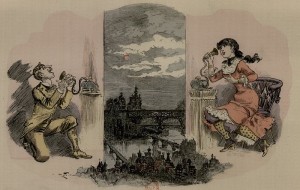
“Moralité, tranquillité, félicité. – La cour téléphonique” from Albert Robida’s “Le vingtième siècle” (1883).
Perhaps because I’d spent the previous couple of weeks finally overcoming my own reluctance to join the smart-phone era, I was particularly struck by the evidence of how long a history there is of uncertainty about this relationship. For every upbeat embrace of the new techology—Albert Robida’s vision of phone-enabled courtship in a futuristic 1883 novel (at left) or the exuberant “Telephone Hour” in Bye Bye Birdie—there have been other, more anxious expressions, ranging from the careful instructions for use that have accompanied every new generation of telephone technology to the classic Sesame Street scene of Martians attempting to identify and communicate with a telephone—“a metaphor,” Marchis noted, “for what happens when people enter into a connection with something impossible to understand.” Elizabeth Richards’ punning 1890 poem “Eletelephony” was an early articulation of the strange blends and disembodiments that the telephone created, while Allen Ginsberg’s “I am a Victim of Telephone” cursed the growing ubiquity of the technology while also recognizing how embedded it had already become in our lives by the 1960s:
When I listen to radio presidents roaring on the convention floor
the phone also chimes in ‘rush up to Harlem with us and see the riots’
Always the telephone linked to all the hearts of the world beating at once…
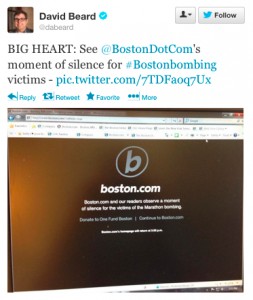 That poem seemed bizarrely apt on that Friday in Ottawa while I was sneaking glances at my own phone to see what was happening in Boston. What would Ginsberg make of a world so hyper-connected that atomized bits of information transmitted by geographically-distant friends have become, for many of us, a primary kind of news media? How should we parse the moment of silence the following Monday that marked the precise instant of the Marathon bombing, during which the Boston Globe blacked out its online operations for a minute while the Twitter commentary on the tribute generated lots of digital noise? How to frame the fact that I can download a recording of Ginsberg reading his poem onto my phone with just a few taps of my finger?
That poem seemed bizarrely apt on that Friday in Ottawa while I was sneaking glances at my own phone to see what was happening in Boston. What would Ginsberg make of a world so hyper-connected that atomized bits of information transmitted by geographically-distant friends have become, for many of us, a primary kind of news media? How should we parse the moment of silence the following Monday that marked the precise instant of the Marathon bombing, during which the Boston Globe blacked out its online operations for a minute while the Twitter commentary on the tribute generated lots of digital noise? How to frame the fact that I can download a recording of Ginsberg reading his poem onto my phone with just a few taps of my finger?
These moments are dense and often baffling. By grounding them in specific technologies and inventions, Vittorio Marchis helped to re-embody and re-emplace histories of technology and discourse that are, on the one hand, stunningly ordinary, and on the other, unimaginably complex. I don’t know why it reassures me to know that I’m part of a long history of ambivalence about the telephone, but it does. It also helps to know that the twists and turns of this cultural history can be traced in surprisingly precise ways. In the guts of the half-dissected machine, for example, Marchis pointed out a couple of mechanisms where the analog was just beginning to give way to the electronic—a tiny opening toward the digitally-mediated culture that most of us now inhabit.
To me, these kinds of insights are where public history can take us when it doesn’t try too hard to resolve all the questions or tidy the edges of knowledge. Marchis refused to be concerned about which category things belonged to—science, art, history—and pursued his own curiosity across all of those boundaries. At the very end of his performance, he also underscored the ritual aspects of this kind of exploration, when he said that he saw this kind of public lecture as a rite undertaken with the participation of the audience, whom he then invited to come forward and take a piece of the anatomized body. People flocked to the front of the room and reached for bits of wire and plastic that had been transformed into meaningful artifacts by an hour’s close and careful attention. Several paused first to memorialize the dissection table with a quick photograph on their phones. Ordinary and extraordinary reality merged for a moment, exposing the essential strangeness of our attempt to connect across time and distance and the near-miraculous quality of human imagination that occasionally allows us to do it.
~ Cathy Stanton teaches in the Anthropology Department at Tufts University and practices public history in a variety of settings.
(Photos are by the author unless otherwise credited. Additional photos from the April 19, 2013 machine autopsy in Ottawa can be found in NCPH’s Flickr stream and Serge Noiret’s Google+ album.)




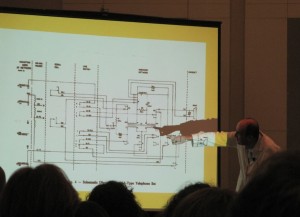
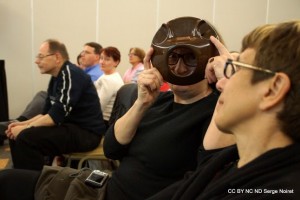
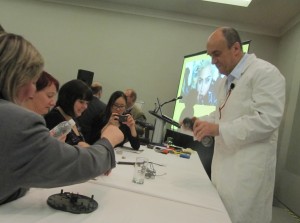
This post makes me all the sadder to have missed this session at the conference! It does make me think of Ariana Reines’ play “Telephone,” which delves into many of these issues through 3 vignettes about communication and miscommunication through technology. The first two are historical–a comic imagining of Alexander Graham Bell and Watson arguing over who said what on the first phone call and a monologue based on a patient of Carl Jung’s who believed she had swallowed a telephone which explained the voices she heard. The play used history and historical forms, to raise questions about technology and subjectivity without, as you brilliantly suggest trying “too hard to resolve all the questions or tidy the edges of knowledge.” Public history could perhaps take a page from the theater in this regard!
Thanks for this thoughtful post, Cathy. With my phone unusable across the border (another layer for Marchis to dissect?) I had the option of keeping more distance from events in Boston, or at least the media coverage thereof….and was grateful for the buffer. The performance was so rich and dense, I feel like I’d like to watch it a few more times with a pause button at the ready to take it all in. But since then, like Mary, I keep noticing art that references phones….& can’t resist sharing this little meditation on the fragment I brought home — maybe he used this; it is all something of a blur now — but here is Christina Pugh’s Rotary: http://www.loc.gov/poetry/180/085.html
Love the poem. He didn’t use that one – and it makes me wonder how many more great telephone poems are out there! Also makes me wonder if there are technologies that inspire this kind of rich response more than others. Did you see his vacuum cleaner autopsy at Smith? Somehow I can’t imagine as much of a poetic outpouring about the vacuum cleaner…